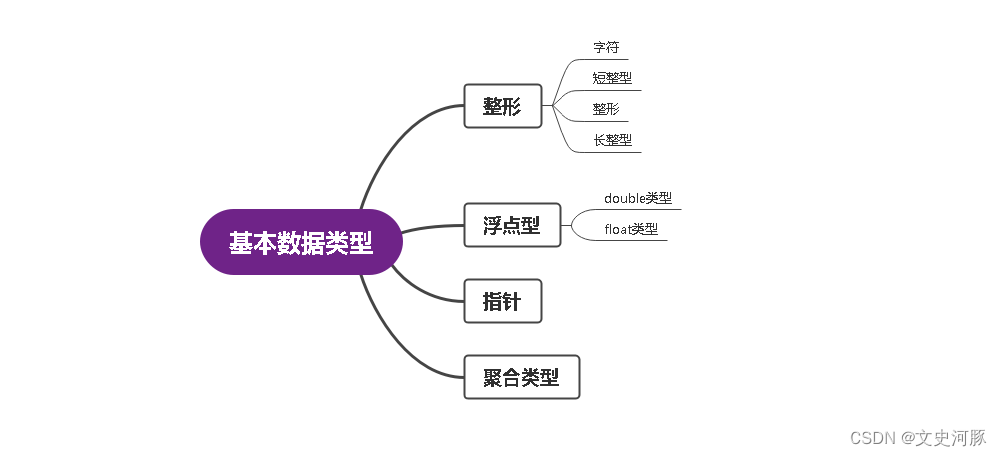MSP430单片机C语言变量类型全解析:数据存储与操作指南
发布时间: 2024-07-08 19:03:36 阅读量: 108 订阅数: 25 


# 1. MSP430单片机C语言变量类型概述
MSP430单片机C语言中的变量类型用于定义变量所存储数据的类型和范围。变量类型决定了变量可以存储的值的范围、精度和存储空间。MSP430单片机C语言支持多种变量类型,包括基本数据类型(整数类型、浮点类型和字符类型)和派生数据类型(数组、结构体和联合体)。基本数据类型是C语言中定义的预定义类型,而派生数据类型是用户自定义的类型。
# 2. MSP430单片机C语言基本数据类型
### 2.1 整数类型
MSP430单片机C语言支持多种整数类型,包括有符号整数类型和无符号整数类型。
#### 2.1.1 有符号整数类型
有符号整数类型可以表示正数、负数和零。MSP430单片机C语言支持以下有符号整数类型:
| 类型 | 字节数 | 取值范围 |
|---|---|---|
| `char` | 1 | -128~127 |
| `short` | 2 | -32768~32767 |
| `int` | 2 | -32768~32767 |
| `long` | 4 | -2147483648~2147483647 |
#### 2.1.2 无符号整数类型
无符号整数类型只能表示正数和零。MSP430单片机C语言支持以下无符号整数类型:
| 类型 | 字节数 | 取值范围 |
|---|---|---|
| `unsigned char` | 1 | 0~255 |
| `unsigned short` | 2 | 0~65535 |
| `unsigned int` | 2 | 0~65535 |
| `unsigned long` | 4 | 0~4294967295 |
### 2.2 浮点类型
MSP430单片机C语言支持两种浮点类型:单精度浮点类型和双精度浮点类型。
#### 2.2.1 单精度浮点类型
单精度浮点类型使用 32 位存储,可以表示范围较大的数字。其取值范围约为 -3.402823e+38~3.402823e+38。
#### 2.2.2 双精度浮点类型
双精度浮点类型使用 64 位存储,可以表示范围更大的数字。其取值范围约为 -1.7976931348623157e+308~1.7976931348623157e+308。
### 2.3 字符类型
MSP430单片机C语言支持两种字符类型:单字符类型和字符串类型。
#### 2.3.1 单字符类型
单字符类型使用一个字节存储,可以表示一个字符。其取值范围为 0~255。
#### 2.3.2 字符串类型
字符串类型使用一个字符数组存储,可以表示一串字符。其取值范围为 0~255。
**代码块:**
```c
#include <stdio.h>
int main() {
// 定义一个有符号整数变量
int num = 10;
// 定义一个无符号整数变量
unsigned int unum = 20;
// 定义一个单精度浮点变量
float fnum = 3.14;
// 定义一个双精度浮点变量
double dfnum = 1.23456789;
// 定义一个单字符变量
char ch = 'a';
// 定义一个字符串变量
char str[] = "Hello World";
// 打印变量的值
printf("有符号整数变量:%d\n", num);
printf("无符号整数变量:%u\n", unum);
printf("单精度浮点变量:%f\n", fnum);
printf("双精度浮点变量:%lf\n", dfnum);
printf("单字符变量:%c\n", ch);
printf("字符串变量:%s\n", str);
return 0;
}
```
**逻辑分析:**
这段代码演示了如何定义和使用 MSP430 单片机 C 语言中的基本数据类型。它定义了六个变量,包括有符号整数、无符号整数、单精度浮点、双精度浮点、单字符和字符串。然后,它打印每个变量的值。
# 3.1 变量的存储位置
变量在MSP430单片机中的存储位置主要分为寄存器、RAM和ROM三种。
#### 3.1.1 寄存器变量
寄存器变量是存储在MSP430单片机内部寄存器中的变量。寄存器变量具有访问速度快、占用存储空间小等优点,但数量有限,一般用于存储需要快速访问的数据,如程序计数器、堆栈指针等。
#### 3.1.2 RAM变量
RAM变量是存储在MSP430单片机内部RAM中的变量。RAM变量具有读写速度快、容量大等优点,但其内容在掉电后会丢失。RAM变量一般用于存储需要频繁读写的临时数据,如函数局部变量、数组等。
#### 3.1.3 ROM变量
ROM变量是存储在MSP430单片机内部ROM中的变量。ROM变量具有内容不可修改、掉电后不丢失等优点,但其读写速度较慢。ROM变量一般用于存储程序代码、常量数据等。
### 3.2 变量的存储大小
变量的存储大小取决于其数据类型。MSP430单片机中不同数据类型的存储大小如下:
#### 3.2.1 整数变量的存储大小
| 数据类型 | 存储大小 |
|---|---|
| char | 1字节 |
| short | 2字节 |
| int | 2字节 |
| long | 4字节 |
#### 3.2.2 浮点变量的存储大小
| 数据类型 | 存储大小 |
|---|---|
| float | 4字节 |
| double | 8字节 |
#### 3.2.3 字符变量的存储大小
字符变量的存储大小为1字节。
# 4. MSP430单片机C语言变量操作技巧
### 4.1 变量的定义和赋值
#### 4.1.1 变量的定义
变量的定义是为变量分配内存空间并指定其数据类型和名称的过程。在C语言中,变量的定义语法如下:
```c
数据类型 变量名;
```
例如,定义一个名为`temperature`的整数变量:
```c
int temperature;
```
#### 4.1.2 变量的赋值
变量赋值是将一个值存储到变量中。在C语言中,变量赋值语法如下:
```c
变量名 = 值;
```
例如,将值`25`赋值给变量`temperature`:
```c
temperature = 25;
```
### 4.2 变量的类型转换
类型转换是指将一种数据类型的值转换为另一种数据类型的值。在C语言中,有以下几种类型转换:
#### 4.2.1 整数类型之间的转换
整数类型之间的转换可以通过强制类型转换运算符`(type)`实现。例如,将`int`类型的值转换为`char`类型:
```c
char c = (char)i;
```
#### 4.2.2 浮点类型之间的转换
浮点类型之间的转换可以通过强制类型转换运算符`(type)`实现。例如,将`float`类型的值转换为`double`类型:
```c
double d = (double)f;
```
#### 4.2.3 整数类型与浮点类型之间的转换
整数类型与浮点类型之间的转换可以通过`atof()`和`atoi()`函数实现。`atof()`函数将字符串转换为浮点类型,`atoi()`函数将字符串转换为整数类型。例如,将字符串`“25.5”`转换为浮点类型:
```c
float f = atof("25.5");
```
### 4.3 变量的指针操作
#### 4.3.1 指针变量的定义和使用
指针变量是指向另一个变量的地址的变量。在C语言中,指针变量的定义语法如下:
```c
数据类型 *指针变量名;
```
例如,定义一个指向`temperature`变量的指针变量`ptr`:
```c
int *ptr = &temperature;
```
指针变量可以用于访问和修改其他变量的值。例如,通过指针变量`ptr`修改`temperature`变量的值:
```c
*ptr = 30;
```
#### 4.3.2 指针变量的运算
指针变量可以进行以下运算:
* **地址运算:**`&`运算符获取变量的地址,`*`运算符获取指针变量指向的变量的值。
* **加法和减法运算:**指针变量可以与整数相加或相减,结果指向相对于当前地址偏移指定字节数的地址。
* **比较运算:**指针变量可以进行比较运算,判断指向的变量是否相等或不相等。
例如,以下代码使用指针变量`ptr`访问和修改`temperature`变量的值:
```c
// 获取 temperature 变量的地址
int *ptr = &temperature;
// 通过指针变量修改 temperature 变量的值
*ptr = 30;
// 通过指针变量获取 temperature 变量的值
int value = *ptr;
```
# 5. MSP430单片机C语言变量在实际应用中的实践
在实际应用中,MSP430单片机C语言变量扮演着至关重要的角色。它们用于存储和处理各种数据,实现复杂的控制和计算功能。以下是一些常见的应用场景:
### 5.1 变量在数据采集中的应用
数据采集是单片机系统中一项重要的任务。变量在数据采集中发挥着关键作用,用于存储采集到的数据,并为后续处理提供基础。
**5.1.1 温度采集**
```c
// 定义温度变量
int temperature;
// 温度采集函数
void temperature_collect() {
// 从传感器读取温度值
temperature = read_temperature_sensor();
}
```
**5.1.2 湿度采集**
```c
// 定义湿度变量
float humidity;
// 湿度采集函数
void humidity_collect() {
// 从传感器读取湿度值
humidity = read_humidity_sensor();
}
```
### 5.2 变量在电机控制中的应用
电机控制是单片机系统中另一个重要的应用领域。变量在电机控制中用于存储电机控制参数,并根据这些参数生成控制信号。
**5.2.1 电机速度控制**
```c
// 定义电机速度变量
int motor_speed;
// 电机速度控制函数
void motor_speed_control() {
// 根据目标速度计算控制参数
motor_speed = calculate_control_parameters(target_speed);
// 生成控制信号
output_control_signal(motor_speed);
}
```
**5.2.2 电机方向控制**
```c
// 定义电机方向变量
int motor_direction;
// 电机方向控制函数
void motor_direction_control() {
// 根据目标方向设置控制参数
motor_direction = set_control_parameters(target_direction);
// 生成控制信号
output_control_signal(motor_direction);
}
```
0
0





